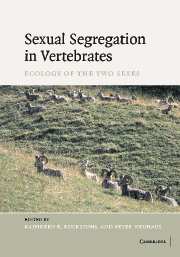Book contents
- Frontmatter
- Contents
- List of contributors
- Preface
- Part I Overview
- Part II Concepts and methodology
- Part III Foraging ecology
- Part IV Predator avoidance and reproductive strategies
- Part V Sex-related activities and social factors
- Part VI Sexual differences in ecology: comparisons within different taxa
- Part VII Implications for conservation
- Part VIII Outlook
- 20 Conclusions and future directions
- References
- Index
20 - Conclusions and future directions
Published online by Cambridge University Press: 04 September 2009
- Frontmatter
- Contents
- List of contributors
- Preface
- Part I Overview
- Part II Concepts and methodology
- Part III Foraging ecology
- Part IV Predator avoidance and reproductive strategies
- Part V Sex-related activities and social factors
- Part VI Sexual differences in ecology: comparisons within different taxa
- Part VII Implications for conservation
- Part VIII Outlook
- 20 Conclusions and future directions
- References
- Index
Summary
OVERVIEW
Sexual segregation is predominant in sexually dimorphic ungulates and is generally a common feature in vertebrates and also occurs in some invertebrates as described recently in squids (Arkhipkin, 2002). When we first had the idea of this book we did not know if, and to what extent, non-ungulate species showed this phenomenon. We think that the contributors to this volume have done a great job in describing what is known about sexual segregation, not only in ungulates but also in a wide variety of other vertebrate species. However, this book is not only an update of what is known about this topic in vertebrates, but within the different chapters it also discusses what is not known and where future research could and should progress in clarifying the causes and consequences of sexual segregation. The novelty of this book is the collection and discussion of the many different consequences and probable causes of sexual segregation on many different levels. While different taxa have been looked at and described in this book, notably ungulates (Chapters 2, 3, 9, 10, 11 and 19), marsupials (Chapter 14), primates, including humans (Chapters 12 and 17), odontocetes (Chapter 16), bats (Chapter 15), birds (Chapters 5, 6 and 18), seals (Chapter 4), sharks (Chapter 8), reptiles (Chapter 13) and to a certain extent other fish (Chapter 7), other important groups such as rodents or carnivores (other than seals) have not been dealt with.
- Type
- Chapter
- Information
- Sexual Segregation in Vertebrates , pp. 395 - 402Publisher: Cambridge University PressPrint publication year: 2006
- 1
- Cited by

